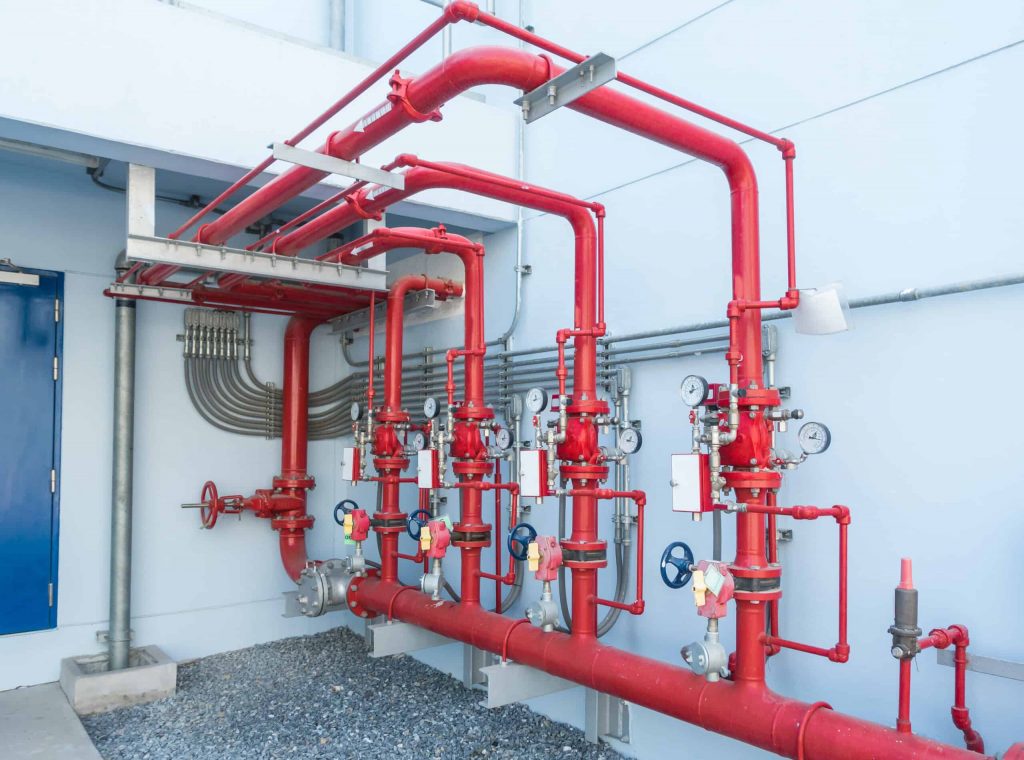

Deluge System
A deluge system is a fixed fire suppression system made to withstand serious fuel hazards. To put an unwanted fire occurrence under control, many sprinklers are operating at once.
The deluge system, which consists of open sprinkler heads and unpressurized dry pipes, is directly connected to a water supply. When activated, a deluge valve simultaneously discharges water to all of the open sprinkler heads.
Other fire-suppressing substances, such as dry powder, foam, chemicals, or inert gases, can also be released by deluge systems. The system piping is empty and dry up until the deluge valve is activated by an electric, pneumatic, hydraulic, or manual release system, but once it is, the deluge system floods the region with pressured water or other fire extinguishing substance.
In high-risk locations including chemical facilities, aeroplane hangars, and power plants, deluge systems are employed. Due to the simultaneous distribution of water or another fire suppressant to all open sprinkler heads, these systems are particularly successful in risky environments. This total flood approach extinguishes a fire before it has a chance to go out of control.

Any one or a combination of the following are the primary goals of using deluge systems.
- Extinguishment of fire
- Control of burning
- Exposure protection
- Prevention of fire
Benefits of deluge fire sprinkler systems.
Deluge fire sprinkler systems are similar to traditional systems in that they spray water through pipes and sprinkler nozzles to slow or stop a fire once activated. Unlike many systems that have closed nozzles and lines that are pressurized with air, deluge sprinklers feature open nozzles and empty, non-pressurized lines. In the event of activation, a control valve opens and floods the sprinkler lines with water that is discharged through all nozzles in the system.
Deluge sprinkler systems are frequently used in settings where a large volume of water would be required to control a fire. Common examples of facilities that use deluge sprinkler systems include aircraft hangars, oil extraction facilities, and buildings where quantities of chemicals or other materials with a low flash point are stored.
Since these systems are designed to discharge water to all sprinkler nozzles, they offer the best protection for control of a fire. Another benefit of deluge sprinkler systems is that they can also be used in conjunction with foam concentrate to better control certain types of fire.

How is a Deluge System activated?
The sprinkler heads on a Deluge system are fused together and perform as one when activated. The valve is opened when activated with the aid of using heat or smoke detection systems. Once activated, the water is released into the piping and out of the sprinkler heads.
Since there may be no water at the pipe and all of the heads are open, a method of release is needed for activation. There are a few approaches a Deluge system can be activated. These methods include hydraulic, pneumatic, electric, or manual release and depend upon the type of machine, which will be defined under the “types” section below. Systems also can use a combination of those methods. The Deluge Valve, however, can most effective be activated hydraulically.
What are the types of Deluge systems?
There are numerous types of Deluge systems. Some are electronically operated so that after an alarm is set off through a detector, pull station, etc., it’s going to energize a solenoid valve releasing the high water off of the top of the valve and allowing the Deluge Valve to trip and deliver water to the threat.
Another sort of Deluge system would be pneumatic. This sort of Deluge system makes use of a small airline with sprinkler heads on it as the detection line. In the event of a fire, the sprinkler heads at the small detection airline are activated so as to expend the air withinside the line allowing the pneumatic actuator at the Deluge Valve to open releasing high water from the top of the valve and allow water to be delivered to the threat.
Deluge Valves may be installed in a threat to apply foam solution rather than only water. It simply depends at the threat being protected.
Does my building need a Deluge Fire Suppression System?
A licensed fire protection company should be able to answer this question. Choose a fire protection company with experience dealing with Deluge systems. The type of fire suppression system used to protect your building should be chosen based on a number of criteria, namely the size of your building and the hazard it protects.
The good news is AITO has capable technician that can possess the required abilities and information.


